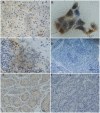Alternative splicing of the porcine glycogen synthase kinase 3β (GSK-3β) gene with differential expression patterns and regulatory functions
- PMID: 22792253
- PMCID: PMC3391277
- DOI: 10.1371/journal.pone.0040250
Alternative splicing of the porcine glycogen synthase kinase 3β (GSK-3β) gene with differential expression patterns and regulatory functions
Abstract
Background: Glycogen synthase kinase 3 (GSK3α and GSK3β) are serine/threonine kinases involved in numerous cellular processes and diverse diseases including mood disorders, Alzheimer's disease, diabetes, and cancer. However, in pigs, the information on GSK3 is very limited. Identification and characterization of pig GSK3 are not only important for pig genetic improvement, but also contribute to the understanding and development of porcine models for human disease prevention and treatment.
Methodology: Five different isoforms of GSK3β were identified in porcine different tissues, in which three isoforms are novel. These isoforms had differential expression patterns in the fetal and adult of the porcine different tissues. The mRNA expression level of GSK3β isoforms was differentially regulated during the course of the insulin treatment, suggesting that different GSK3β isoforms may have different roles in insulin signaling pathway. Moreover, GSK3β5 had a different role on regulating the glycogen synthase activity, phosphorylation and the expression of porcine GYS1 and GYS2 gene compared to other GSK3β isoforms.
Conclusions: We are the first to report five different isoforms of GSK3β identified from the porcine different tissues. Splice variants of GSK3β exhibit differential activity towards glycogen synthase. These results provide new insight into roles of the GSK3β on regulating glycogen metabolism.
Conflict of interest statement
Figures









Similar articles
-
Transcriptional regulation of pig GYS1 gene by glycogen synthase kinase 3β (GSK3β).Mol Cell Biochem. 2017 Jan;424(1-2):203-208. doi: 10.1007/s11010-016-2856-1. Epub 2016 Oct 26. Mol Cell Biochem. 2017. PMID: 27785702
-
Multiple alternative splicing and differential expression patterns of the glycogen synthase kinase-3β (GSK3β) gene in Schizothorax prenanti.Comp Biochem Physiol B Biochem Mol Biol. 2015 Mar;181:1-6. doi: 10.1016/j.cbpb.2014.11.004. Epub 2014 Nov 15. Comp Biochem Physiol B Biochem Mol Biol. 2015. PMID: 25461676
-
Molecular and functional characterization of glycogen synthase in the porcine satellite cells under insulin treatment.Mol Cell Biochem. 2012 Jan;360(1-2):169-80. doi: 10.1007/s11010-011-1054-4. Epub 2011 Sep 20. Mol Cell Biochem. 2012. PMID: 21931959
-
GSK3beta signalling: casting a wide net in Alzheimer's disease.Neurosignals. 2002 Sep-Oct;11(5):251-61. doi: 10.1159/000067423. Neurosignals. 2002. PMID: 12566926 Review.
-
GSK3 in Alzheimer's disease: mind the isoforms.J Alzheimers Dis. 2014;39(4):707-10. doi: 10.3233/JAD-131661. J Alzheimers Dis. 2014. PMID: 24254703 Free PMC article. Review.
Cited by
-
Transcriptional regulation of pig GYS1 gene by glycogen synthase kinase 3β (GSK3β).Mol Cell Biochem. 2017 Jan;424(1-2):203-208. doi: 10.1007/s11010-016-2856-1. Epub 2016 Oct 26. Mol Cell Biochem. 2017. PMID: 27785702
-
GSK3β inhibition attenuates LPS-induced IL-6 expression in porcine adipocytes.Sci Rep. 2018 Oct 29;8(1):15967. doi: 10.1038/s41598-018-34186-0. Sci Rep. 2018. PMID: 30374048 Free PMC article.
-
Fruitflow inhibits platelet function by suppressing Akt/GSK3β, Syk/PLCγ2 and p38 MAPK phosphorylation in collagen-stimulated platelets.BMC Complement Med Ther. 2022 Mar 17;22(1):75. doi: 10.1186/s12906-022-03558-5. BMC Complement Med Ther. 2022. PMID: 35300669 Free PMC article.
-
GSK3β mediates pancreatic cancer cell invasion in vitro via the CXCR4/MMP-2 Pathway.Cancer Cell Int. 2015 Jul 5;15:70. doi: 10.1186/s12935-015-0216-y. eCollection 2015. Cancer Cell Int. 2015. PMID: 26213494 Free PMC article.
-
GSK3β inhibition suppresses the hepatic lipid accumulation in Schizothorax prenanti.Fish Physiol Biochem. 2019 Dec;45(6):1953-1961. doi: 10.1007/s10695-019-00691-w. Epub 2019 Aug 10. Fish Physiol Biochem. 2019. PMID: 31401708
References
-
- Woodgett JR, Cohen P. Multisite Phosphorylation of Glycogen-Synthase - Molecular-Basis for the Substrate-Specificity of Glycogen-Synthase Kinase-3 and Casein Kinase-Ii (Glycogen-Synthase Kinase-5). Biochimica Et Biophysica Acta. 1984;788:339–347. - PubMed
-
- Rylatt DB, Aitken A, Bilham T, Condon GD, Embi N, et al. Glycogen-Synthase from Rabbit Skeletal-Muscle - Amino-Acid-Sequence at the Sites Phosphorylated by Glycogen-Synthase Kinase-3, and Extension of the N-Terminal Sequence Containing the Site Phosphorylated by Phosphorylase-Kinase. Euro J Biochem. 1980;107:529–537. - PubMed
-
- Ding VW, Chen RH, McCormick F. Differential regulation of glycogen synthase kinase 3 beta by insulin and Wnt signaling. J Biol Chem. 2000;275:32475–32481. - PubMed
-
- Rubinfeld B, Albert I, Porfiri E, Fiol C, Munemitsu S, et al. Binding of GSK3beta to the APC-beta-catenin complex and regulation of complex assembly. Science. 1996;272:1023–1026. - PubMed
Publication types
MeSH terms
Substances
LinkOut - more resources
Full Text Sources
Molecular Biology Databases
Miscellaneous

